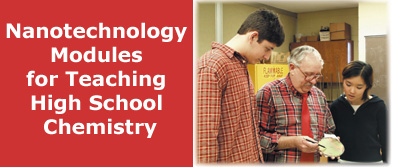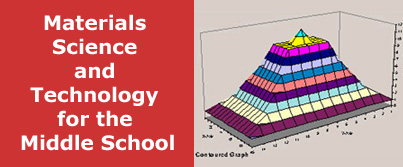

Exploring the Nanoworld > Programs > RET > Modules
 These materials
have been created in conjuction with the National Science Foundation's Research
Experience for Teachers Program and the K-Through-Infinity Program at the University
of Wisconsin-Madison. These
documents are DRAFTS of the work that has been produced to date.
These materials
have been created in conjuction with the National Science Foundation's Research
Experience for Teachers Program and the K-Through-Infinity Program at the University
of Wisconsin-Madison. These
documents are DRAFTS of the work that has been produced to date.

These modules were designed for to show how x-ray diffraction and scanning probe microscopy (SPM), shape-memory alloys, light emitting diodes, ferrofluid and other metal nanoparticles illustrate basic science concepts covered in the traditional high school science curriculum.
This activity is intended for high-school chemistry, physics, and mathematics students, taking 55 minutes plus 10 minutes setup time. After completing the activity, students will be able to identify and name the three types of carbon nanotubes; and add vectors tail to head to determine the circumference of a carbon nanotube.
Using simple materials to illustrate complex processes, students learn how the scientific techniques of SPM and diffraction have provided us with a great deal of information about materials, including the double helix structure of DNA.
Nickel-titanium (NiTi) is a remarkable metal alloy that will return to it's original shape when heated by hot air or water. This material is used to illustrate how novel properties can occur when alloys are created and how phases changes can occur between two solid phases.
LEDs are made up of a small semiconducting crystal whose chemical composition can be tuned by taking advantage of various atomic properties such as electronegativity, and atomic radius. Students can see many examples of this cutting-edge science all around them as indicator lights in their computers, and increasingly in traffic lights and animated billboards.
Using simple synthetic techniques ferrofluid, a suspension of nanoscale magnetic particles suspended in a fluid can be prepared by students. Students can investigate this unique material that is being used by NASA and medical professionals to make many scientific advances.
Curriculum connections for the modules including an introductory classroom activity, connections to National Science Education Standards, connections to the Chem Study curriculum, a Glossary, and references can help teachers implement this new curriculum.

Created for a technology class, these modules include activities that help students understand the question: How can we "see" what we cannot see? Students are able to learn how scientists can understand objects that are too small for them to see with an optical microscope, such as atoms. Students are able to probe an object that they cannot see, make measurements to determine its shape and see how computers can be used to help interpret data. Using a spreadsheet program such as Excel students can create a 3-Dimensional representation of their findings. Students also learn how the properties of shape memory alloys can be used to design simple machines such as a catapult or a launcher.
Based on the book by Robert E. Wells, these activities are designed to help students begin to develop mental images of the size, scale, and structure of the atomic world.
These activities will help students begin to understand how we can "see" things that are too small for us to see with our eyes or even a microscope. Students will map an unknown surface using a similar method used to image atoms on a surface.
The purpose of these activities is to provide students with a firm understanding of magnetism. Many advanced technologies rely on magnetism such as computer disk drives, medical Magneto Resonance Imaging (MRI) machines, and ferrofluids.
Students will become familiar with memory metals throughout the use of these activities. Students will begin to understand the connection between memory metal's atomic structure and its physical characteristics, and identify how Nitinol's memory metal characteristics can be used to solve engineering problems.
These modules have been created by Tony Cina, Ann (Pumper) Comins, Jen Ehrlich Bruce Swanson, Jeremiah Neubert, Cindy Widstrand, Matt Vander Zanden, Greta Zenner, Wendy Crone and Arthur Ellis. Funding for this project has been made possible through the National Science Foundation's Materials Research Science and Engineering Center's Research Experience for Teachers program and the GK-12/K-Through-Infinity Professional Development program.